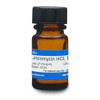Lincomycin Hydrochloride, EP is the hydrochloride form of Lincomycin, provided as the monohydrate. Lincomycin is a naturally occurring lincosamide isolated from Streptomyces licolnensis by researchers at Upjohn in 1962. This class of antibacterial contains a rare amino acid (4-propyl-N-methylprolin) coupled to an equally rare aminomethylthio-octopyranoside sugar. Lincomycin is often incorrectly considered an aminoglycoside but it actually shares little or no structural similarity. It is effective for Gram-positive bacteria and disrupts protein synthesis.
Lincomycin Hydochloride is soluble in water, methanol and ethanol.
Lincomycin Hydrochloride, EP conforms to European Pharmacopoeia specifications.
We also offer:
| Mechanism of Action | Lincosamide antibiotics inhibit bacterial growth by targeting the 50S ribosomal subunit preventing peptide bond formation and translocation during protein synthesis. Resistance to Lincomycin is commonly attributed to mutations in 50S rRNA preventing Lincomycin binding allowing the cell to synthesize proteins free of error. |
| Spectrum | Lincomycin is a narrow-spectrum antibiotic effective against Gram-positive bacteria and protozoa. It is effective for Staphylococcus, Streptococcus, and Bacterioides. It has comparable activity to Erythromycin in vitro. |
| Microbiology Applications | Lincomycin Hydrochloride is commonly used in clinical in vitro microbiological antimicrobial susceptibility tests (panels, discs, and MIC strips) against Gram-positive microbial isolates. Medical microbiologists use AST results to recommend antibiotic treatment options. Representative MIC values include:
|
| Plant Biology Applications | Lincomycin provides a powerful plant selection agent that facilitates recovery of plastid transformants. Cultured Nicotiana cells were used in vitro. Resistant cells are green versus sensitive cells are white on the selective medium. Lincomycin is preferred over other antibiotics for chloroplast transformation because it also inhibits callus formation, greening, and subsequent shoot regeneration (Moll et al, 1990). |
| Molecular Formula | C18H34N2O6S · HCl · H2O |
| Solubility | Soluble in water, methanol and ethanol |
| References |
Geddes AM, Sleet RA and Murdoch JM (1964) Lincomycin Hydrochloride: Clinical and laboratory studies. Brit. Med. J 2:670-672 Josten JJ and Allen PM (1964) The mode of action of Lincomycin. Biochem. Biophys. Res. Comm. 14(3):241-244 PMID 5836512 Lovmar M and Tanel Tenson T (20013) The mechanism of action of macrolides, lincosamides and streptogramin B reveals the nascent peptide exit path in the ribosome. J. Molec. Microbol. 330(5):1005-1014 Popescu-Pelin G et al (2018) Lincomycin-embedded PANI-based coatings for biomedical applications. Appl. Surf. Sci. 455:653-666 |
| MIC | Diplococcus pneumoniae| 0.05 - 0.4|| Haemophilus influenzae| >50|| |







